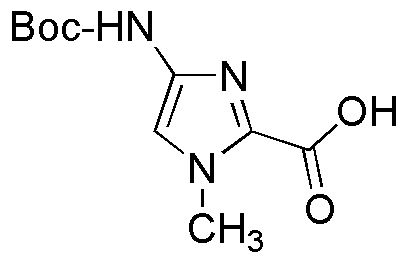4-(Boc-amino)-1-methyl-1H-imidazole-2-carboxylic acid is widely utilized in research focused on:
- Peptide Synthesis: This compound serves as a key building block in the synthesis of peptides, particularly in the pharmaceutical industry, where it helps create therapeutic agents with enhanced efficacy.
- Drug Development: Its unique structure allows for the modification of drug candidates, improving their bioavailability and stability, which is crucial in developing new medications.
- Bioconjugation: The compound can be used in bioconjugation processes, linking biomolecules to drugs or imaging agents, thereby enhancing targeted delivery in cancer therapies.
- Research in Biochemistry: It plays a significant role in biochemical research, helping scientists understand enzyme mechanisms and protein interactions, which are essential for drug discovery.
- Material Science: Its properties make it suitable for creating advanced materials, including hydrogels and coatings, which have applications in drug delivery systems and tissue engineering.
General Information
Properties
Safety and Regulations
Applications
4-(Boc-amino)-1-methyl-1H-imidazole-2-carboxylic acid is widely utilized in research focused on:
- Peptide Synthesis: This compound serves as a key building block in the synthesis of peptides, particularly in the pharmaceutical industry, where it helps create therapeutic agents with enhanced efficacy.
- Drug Development: Its unique structure allows for the modification of drug candidates, improving their bioavailability and stability, which is crucial in developing new medications.
- Bioconjugation: The compound can be used in bioconjugation processes, linking biomolecules to drugs or imaging agents, thereby enhancing targeted delivery in cancer therapies.
- Research in Biochemistry: It plays a significant role in biochemical research, helping scientists understand enzyme mechanisms and protein interactions, which are essential for drug discovery.
- Material Science: Its properties make it suitable for creating advanced materials, including hydrogels and coatings, which have applications in drug delivery systems and tissue engineering.
Documents
Safety Data Sheets (SDS)
The SDS provides comprehensive safety information on handling, storage, and disposal of the product.
Product Specification (PS)
The PS provides a comprehensive breakdown of the product’s properties, including chemical composition, physical state, purity, and storage requirements. It also details acceptable quality ranges and the product's intended applications.
Certificates of Analysis (COA)
Search for Certificates of Analysis (COA) by entering the products Lot Number. Lot and Batch Numbers can be found on a product’s label following the words ‘Lot’ or ‘Batch’.
*Catalog Number
*Lot Number
Certificates Of Origin (COO)
This COO confirms the country where the product was manufactured, and also details the materials and components used in it and whether it is derived from natural, synthetic, or other specific sources. This certificate may be required for customs, trade, and regulatory compliance.
*Catalog Number
*Lot Number
Safety Data Sheets (SDS)
The SDS provides comprehensive safety information on handling, storage, and disposal of the product.
DownloadProduct Specification (PS)
The PS provides a comprehensive breakdown of the product’s properties, including chemical composition, physical state, purity, and storage requirements. It also details acceptable quality ranges and the product's intended applications.
DownloadCertificates of Analysis (COA)
Search for Certificates of Analysis (COA) by entering the products Lot Number. Lot and Batch Numbers can be found on a product’s label following the words ‘Lot’ or ‘Batch’.
*Catalog Number
*Lot Number
Certificates Of Origin (COO)
This COO confirms the country where the product was manufactured, and also details the materials and components used in it and whether it is derived from natural, synthetic, or other specific sources. This certificate may be required for customs, trade, and regulatory compliance.


